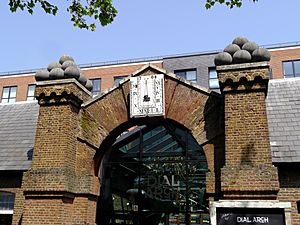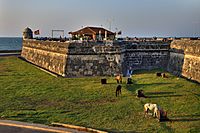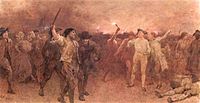William Belford facts for kids
Quick facts for kids
General William Belford
|
|
|---|---|

Dial Square, Royal Arsenal
|
|
| Born | about 1712 Maidstone, Kent |
| Died | 1 July 1780 Dial Square, Royal Arsenal |
| Allegiance | |
| Service/ |
|
| Years of service | 1726-1758 |
| Rank | General 29 August 1777 |
| Unit | Colonel, Royal Regiment of Artillery 1751–1758 |
| Commands held | Commandant of the Royal Arsenal 1758-1780 |
| Battles/wars | War of Jenkins' Ear Cartagena de Indias War of the Austrian Succession Dettingen Fontenoy Jacobite rising of 1745 Second Siege of Carlisle Culloden |
General William Belford (1712 – 1 July 1780) was a brave British army officer. He specialized in artillery, which means he worked with cannons and big guns. He started his career in 1726.
William Belford was special because he was one of the first officers chosen for his skills. Before him, many officers got their jobs because of family connections. From 1743 to 1748, he served under the Duke of Cumberland. He fought in Europe and in Britain during the Jacobite rising of 1745. In 1751, he became a Colonel in the Royal Regiment of Artillery. Later, he led the First Battalion of this regiment. From 1758 until he died in 1780, he was in charge of the Royal Arsenal. This was a very important place where weapons were made and stored.
Contents
Early Life and Family
William Belford was born in Maidstone, Kent, around 1712. His father, Gustavus Belford, was a Captain in the Royal Regiment of Dragoons. William had several brothers and sisters, but only a few lived to be adults. These included Hester, Mary, and Elizabeth.
In 1744, William Belford married Martha Schalch. Her father, Andrew Schalch, also worked at the Royal Arsenal. William and Martha had six children together. Sadly, many of their children died young. Their sons William and Gustavus both became army officers. Martha died in 1766.
General Belford also had another son named William. This son was born in 1762. He also joined the army and became a Lieutenant Colonel. He later became Fort Major of Dartmouth Castle.
Military Career
In the early 1700s, the British army often created new regiments for each war. These regiments were then disbanded when the war ended. However, there were always some trained gunners. These gunners worked in important places like the Tower of London. They were controlled by the Ordnance Office, which managed military supplies.
Britain realized it needed a more professional army, especially for artillery and engineering. So, in 1716, two permanent companies of field artillery were formed. These became the Royal Regiment of Artillery in 1720.
Joining the Artillery
Belford joined the artillery as a cadet in 1726. Unlike other parts of the army, officers in the Royal Artillery were chosen for their skills. They didn't have to buy their positions. Belford quickly showed he was good with technology and military equipment. He even spent time on a bomb vessel in 1738. These ships carried powerful cannons. He also worked with the sappers and miners in 1739.
Fighting in Wars
During the War of Jenkins' Ear against Spain, Belford went to the Spanish West Indies in 1740. In 1741, he was part of a difficult attack on Cartagena de Indias. This attack was unsuccessful. Many soldiers died from diseases like yellow fever. Even so, Belford gained a good reputation and was promoted to captain.

Belford then served in the War of the Austrian Succession. He fought in Europe under the Duke of Cumberland. He was at the Battle of Dettingen in 1743 and the Battle of Fontenoy in 1745.
The Jacobite Rising
In 1745, there was a rebellion in Britain called the Jacobite rising of 1745. Belford was in charge of the artillery during the Second Siege of Carlisle in December 1745. He also fought at the Battle of Culloden in April 1746. After this, he returned to Europe. He was promoted to Colonel in December 1746. He focused a lot on training his gunners. He taught them how to use small arms and practice weapon drills.
Leading the Royal Artillery
In 1751, Belford became the Colonel of the Royal Artillery regiment. In 1757, a second battalion was created, and he led the First Battalion. In 1758, he became the Commandant of the Royal Arsenal. This was a very important leadership role. He was promoted to General in 1777. By the time he died in 1780, the Royal Artillery was much larger. It had over 5,000 men and officers.
The Gordon Riots

In June 1780, there were big riots in London called the Gordon Riots. These riots started because some people were angry about a new law. This law reduced restrictions on Catholics. The riots led to a lot of violence and looting. Rioters tried to attack the Bank of England and the Royal Arsenal. General Belford successfully organized the defense of the Arsenal. Parliament later gave him money for his excellent service. However, his efforts during the riots made him very ill. He died on July 1, 1780, in his rooms at the Arsenal.
Legacy
General William Belford made important contributions to the army. He supported using a special screw system to aim cannons more accurately. This was better than the old method of using wedges. He is also said to have brought the fife instrument to the British army in 1748. He hired a musician to teach the instrument to the Royal Artillery Band.
Images for kids
-
Part of the defenses at Cartagena de Indias in modern Colombia. Belford fought in the attack here in 1741.
-
The Gordon Riots in June 1780. Belford protected the Royal Arsenal during these riots.




